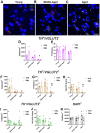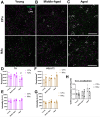This is a preprint.
Aging disrupts the coordination between mRNA and protein expression in mouse and human midbrain
- PMID: 38854057
- PMCID: PMC11160743
- DOI: 10.1101/2024.06.01.596950
Aging disrupts the coordination between mRNA and protein expression in mouse and human midbrain
Update in
-
Aging disrupts the coordination between mRNA and protein expression in mouse and human midbrain.Mol Psychiatry. 2025 Jul;30(7):3039-3054. doi: 10.1038/s41380-025-02909-1. Epub 2025 Jan 29. Mol Psychiatry. 2025. PMID: 39875589
Abstract
Age-related dopamine (DA) neuron loss is a primary feature of Parkinson's disease. However, it remains unclear whether similar biological processes occur during healthy aging, albeit to a lesser degree. We therefore determined whether midbrain DA neurons degenerate during aging in mice and humans. In mice, we identified no changes in midbrain neuron numbers throughout aging. Despite this, we found age-related decreases in midbrain mRNA expression of tyrosine hydroxylase (Th), the rate limiting enzyme of DA synthesis. Among midbrain glutamatergic cells, we similarly identified age-related declines in vesicular glutamate transporter 2 (Vglut2) mRNA expression. In co-transmitting Th +/Vglut2 + neurons, Th and Vglut2 transcripts decreased with aging. Importantly, striatal Th and Vglut2 protein expression remained unchanged. In translating our findings to humans, we found no midbrain neurodegeneration during aging and identified age-related decreases in TH and VGLUT2 mRNA expression similar to mouse. Unlike mice, we discovered diminished density of striatal TH+ dopaminergic terminals in aged human subjects. However, TH and VGLUT2 protein expression were unchanged in the remaining striatal boutons. Finally, in contrast to Th and Vglut2 mRNA, expression of most ribosomal genes in Th + neurons was either maintained or even upregulated during aging. This suggests a homeostatic mechanism where age-related declines in transcriptional efficiency are overcome by ongoing ribosomal translation. Overall, we demonstrate species-conserved transcriptional effects of aging in midbrain dopaminergic and glutamatergic neurons that are not accompanied by marked cell death or lower striatal protein expression. This opens the door to novel therapeutic approaches to maintain neurotransmission and bolster neuronal resilience.
Keywords: aging; dopamine; glutamate; neurodegeneration; ribosome; tyrosine hydroxylase; vesicular glutamate transporter 2.
Conflict of interest statement
Conflicts of Interest The authors report no conflicts of interest.
Figures







Similar articles
-
Aging disrupts the coordination between mRNA and protein expression in mouse and human midbrain.Mol Psychiatry. 2025 Jul;30(7):3039-3054. doi: 10.1038/s41380-025-02909-1. Epub 2025 Jan 29. Mol Psychiatry. 2025. PMID: 39875589
-
Dopamine neurons exhibit emergent glutamatergic identity in Parkinson's disease.Brain. 2022 Apr 29;145(3):879-886. doi: 10.1093/brain/awab373. Brain. 2022. PMID: 35258081 Free PMC article.
-
Systemic pharmacological treatments for chronic plaque psoriasis: a network meta-analysis.Cochrane Database Syst Rev. 2021 Apr 19;4(4):CD011535. doi: 10.1002/14651858.CD011535.pub4. Cochrane Database Syst Rev. 2021. Update in: Cochrane Database Syst Rev. 2022 May 23;5:CD011535. doi: 10.1002/14651858.CD011535.pub5. PMID: 33871055 Free PMC article. Updated.
-
Maternal and neonatal outcomes of elective induction of labor.Evid Rep Technol Assess (Full Rep). 2009 Mar;(176):1-257. Evid Rep Technol Assess (Full Rep). 2009. PMID: 19408970 Free PMC article.
-
Parabrachial nucleus Vglut2 expressing neurons projection to the extended amygdala involved in the regulation of wakefulness during sevoflurane anesthesia in mice.CNS Neurosci Ther. 2024 Aug;30(8):e70001. doi: 10.1111/cns.70001. CNS Neurosci Ther. 2024. PMID: 39154359 Free PMC article.
References
-
- Volkow N.D., Ding Y.S., Fowler J.S., Wang G.J., Logan J., Gatley S.J., Hitzemann R., Smith G., Fields S.D., and Gur R. (1996). Dopamine transporters decrease with age. Journal of nuclear medicine : official publication, Society of Nuclear Medicine 37, 554–559. - PubMed
Publication types
Grants and funding
LinkOut - more resources
Full Text Sources
